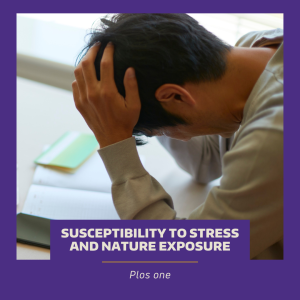Susceptibility to Stress and Nature Exposure: Unveiling Differential Susceptibility to Physical Environments; A Randomized Controlled Trial
Citation
Eisen, A. M., Bratman, G. N., & Olvera Alvarez, H. A. (2024). Susceptibility to stress and nature exposure: Unveiling differential susceptibility to physical environments; a randomized controlled trial. Plos one, 19(4), e0301473. doi.org/10.1371/journal.pone.0301473
 This study explored how spending time in nature might help people recover from stress, especially those who may be more biologically sensitive to their surroundings. Research has suggested that people from lower socioeconomic backgrounds may gain more health benefits from nature exposure than those from higher socioeconomic backgrounds. One explanation is that early life stress can make some people’s bodies more prone to inflammation, which might make them more reactive to stressful situations. On the other hand, it may also make them more responsive to calming or restorative environments like nature.
This study explored how spending time in nature might help people recover from stress, especially those who may be more biologically sensitive to their surroundings. Research has suggested that people from lower socioeconomic backgrounds may gain more health benefits from nature exposure than those from higher socioeconomic backgrounds. One explanation is that early life stress can make some people’s bodies more prone to inflammation, which might make them more reactive to stressful situations. On the other hand, it may also make them more responsive to calming or restorative environments like nature.
To test this idea, researchers studied 64 healthy college-age males with varying levels of susceptibility (socioeconomic status, early life stress, and a pro-inflammatory state). Participants were exposed to a stressful situation and then spent 10 minutes in either a nature or office virtual reality scene. The researchers measured how well their bodies recovered from stress and also assessed biological indicators of inflammation and stress sensitivity.
Results showed that participants with higher inflammation-related responses tended to recover better in the nature setting than in the office setting, though the differences were modest. No clear patterns were found when looking at socioeconomic status or early life stress alone.
These findings suggest that biological measures of inflammation might better capture how sensitive someone is to their environment than traditional factors like income or early life experiences. If future studies confirm this in more diverse groups, it could mean that people who are most biologically sensitive to stress might also benefit the most from nature exposure. This understanding could help guide ways to promote health and well-being through nature-based interventions.
Abstract

Background
Emerging epidemiological evidence indicates nature exposure could be associated with greater health benefits among groups in lower versus higher socioeconomic positions. One possible mechanism underpinning this evidence is described by our framework: (susceptibility) adults in low socioeconomic positions face higher exposure to persistent psychosocial stressors in early life, inducing a pro-inflammatory phenotype as a lifelong susceptibility to stress; (differential susceptibility) susceptible adults are more sensitive to the health risks of adverse (stress-promoting) environments, but also to the health benefits of protective (stress-buffering) environments.
Objective
Experimental investigation of a pro-inflammatory phenotype as a mechanism facilitating greater stress recovery from nature exposure.
Methods
We determined differences in stress recovery (via heart rate variability) caused by exposure to a nature or office virtual reality environment (10 min) after an acute stressor among 64 healthy college-age males with varying levels of susceptibility (socioeconomic status, early life stress, and a pro-inflammatory state [inflammatory reactivity and glucocorticoid resistance to an in vitro bacterial challenge]).
Results
Findings for inflammatory reactivity and glucocorticoid resistance were modest but consistently trended towards better recovery in the nature condition. Differences in recovery were not observed for socioeconomic status or early life stress.
Discussion
Among healthy college-age males, we observed expected trends according to their differential susceptibility when assessed as inflammatory reactivity and glucocorticoid resistance, suggesting these biological correlates of susceptibility could be more proximal indicators than self-reported assessments of socioeconomic status and early life stress. If future research in more diverse populations aligns with these trends, this could support an alternative conceptualization of susceptibility as increased environmental sensitivity, reflecting heightened responses to adverse, but also protective environments. With this knowledge, future investigators could examine how individual differences in environmental sensitivity could provide an opportunity for those who are the most susceptible to experience the greatest health benefits from nature exposure.